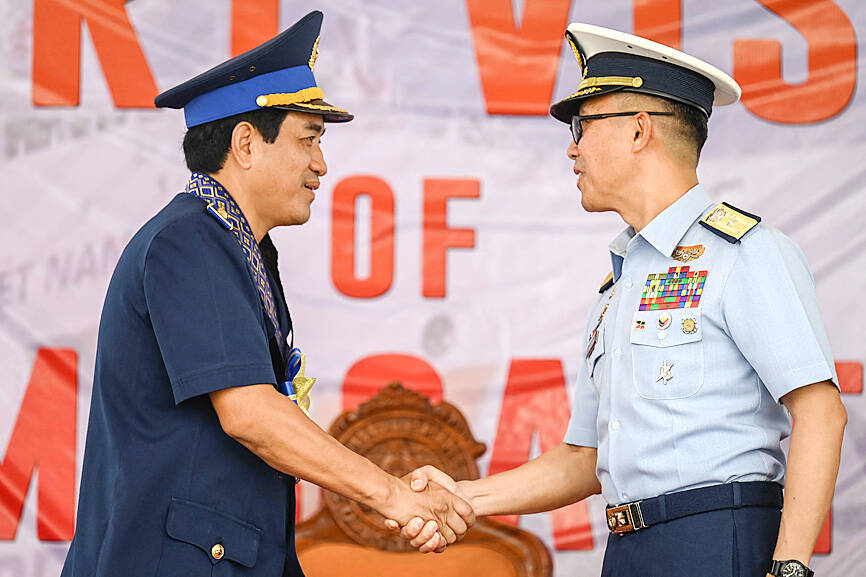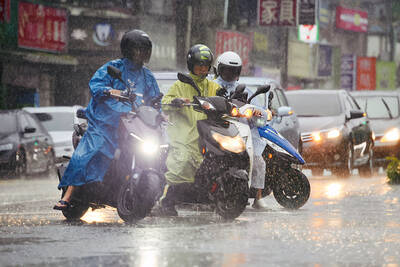A Vietnam Coast Guard ship arrived in Manila yesterday for a four-day goodwill visit and joint exercises as the two nations attempt to put aside their own territorial disputes in the face of rising tensions with China over control of key features in the South China Sea.
The Philippines and Vietnam are among the most vocal critics of China’s increasingly hostile actions in the disputed waters, a key global trade and security route.
The neighboring Southeast Asian nations themselves have overlapping claims in the busy sea passage, along with Taiwan, Malaysia and Brunei, and the disputes are regarded as an Asian flashpoint and a delicate fault line in the US-China regional rivalry.

Photo: AFP
As the host’s coast guard personnel waved Philippine and Vietnamese flags, and a brass band played under the morning sun at Manila’s harbor, a Vietnam Coast Guard ship with 80 crew docked. Some of its officers saluted from the lower and upper decks of the 90m white ship.
While in Manila, the two coast guards are expected to hold talks and tour each other’s ships. They are to hold joint search-and-rescue drills along with fire and explosion contingency drills in Manila Bay, on the western coast of northern Philippines facing the South China Sea.
“This is a good template, a good way to de-escalate the situation,” Philippine Coast Guard spokesperson Rear Admiral Armand Balilo said. “This shows that even rival claimants can have an opportunity to nurture a relationship.”
Colonel Hoang Quoc Dat, who headed the Vietnam Coast Guard’s delegation, said in a speech that the Manila port call was a way to strengthen the two nations’ “cooperative relationship for mutual benefit.”
“This will promote and enhance the efficiency of information sharing and the coordination in maritime law enforcement, in accordance with international law,” he said, adding that such friendly collaboration contributes to “the preservation and protection of the region’s maritime security and safety.”
In a separate goodwill engagement last month, Vietnamese and Philippine navy forces played volleyball, soccer and tug-of-war in the Vietnam-occupied Southwest Cay (Nanzih Reef, 南子礁) in the South China Sea’s hotly contested Spratly Islands (Nansha Islands, 南沙群島), according to Vietnamese and Philippine officials.
Vietnam in June said that it was ready to hold talks with the Philippines to settle their overlapping claims to the undersea continental shelf in the South China Sea, while China has long claimed much of the entire seaway and vowed to defend its territorial interests at all costs.
After a violent June 17 confrontation in the Philippine-occupied Second Thomas Shoal (Renai Shoal, 仁愛暗沙) between Chinese forces — armed with knives, an axe and improvised spears — and Philippine Navy personnel, China and the Philippines reached a temporary agreement last month to prevent further clashes that could spark a major armed conflict in the South China Sea.
A week after the deal was forged, Philippine government personnel transported food and other supplies to Manila’s territorial ship outpost at the shoal, which has been closely guarded by Chinese coast guard and navy ships, and no confrontations were reported.
However, the Philippines has vowed to press on with efforts to strengthen its territorial forces and defense, and expand security alliances with Asian and Western nations.

The combined effect of the monsoon, the outer rim of Typhoon Fengshen and a low-pressure system is expected to bring significant rainfall this week to various parts of the nation, the Central Weather Administration (CWA) said. The heaviest rain is expected to occur today and tomorrow, with torrential rain expected in Keelung’s north coast, Yilan and the mountainous regions of Taipei and New Taipei City, the CWA said. Rivers could rise rapidly, and residents should stay away from riverbanks and avoid going to the mountains or engaging in water activities, it said. Scattered showers are expected today in central and

COOPERATION: Taiwan is aligning closely with US strategic objectives on various matters, including China’s rare earths restrictions, the Ministry of Foreign Affairs said Taiwan could deal with China’s tightened export controls on rare earth metals by turning to “urban mining,” a researcher said yesterday. Rare earth metals, which are used in semiconductors and other electronic components, could be recovered from industrial or electronic waste to reduce reliance on imports, National Cheng Kung University Department of Resources Engineering professor Lee Cheng-han (李政翰) said. Despite their name, rare earth elements are not actually rare — their abundance in the Earth’s crust is relatively high, but they are dispersed, making extraction and refining energy-intensive and environmentally damaging, he said, adding that many countries have opted to

People can preregister to receive their NT$10,000 (US$325) cash distributed from the central government on Nov. 5 after President William Lai (賴清德) yesterday signed the Special Budget for Strengthening Economic, Social and National Security Resilience, the Executive Yuan told a news conference last night. The special budget, passed by the Legislative Yuan on Friday last week with a cash handout budget of NT$236 billion, was officially submitted to the Executive Yuan and the Presidential Office yesterday afternoon. People can register through the official Web site at https://10000.gov.tw to have the funds deposited into their bank accounts, withdraw the funds at automated teller

CONCESSION: A Shin Kong official said that the firm was ‘willing to contribute’ to the nation, as the move would enable Nvidia Crop to build its headquarters in Taiwan Shin Kong Life Insurance Co (新光人壽) yesterday said it would relinquish land-use rights, or known as surface rights, for two plots in Taipei’s Beitou District (北投), paving the way for Nvidia Corp to expand its office footprint in Taiwan. The insurer said it made the decision “in the interest of the nation’s greater good” and would not seek compensation from taxpayers for potential future losses, calling the move a gesture to resolve a months-long impasse among the insurer, the Taipei City Government and the US chip giant. “The decision was made on the condition that the Taipei City Government reimburses the related